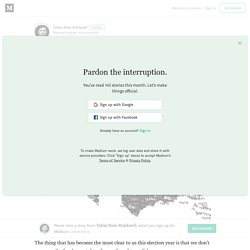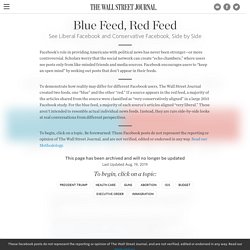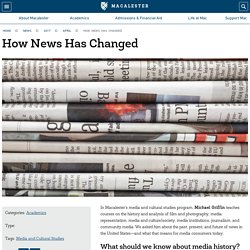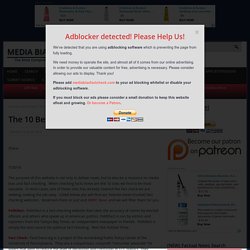

How We Broke Democracy promoted by Monmouth University. The thing that has become the most clear to us this election year is that we don’t agree on the fundamental truths we thought we did.

I went to college in the part of Pennsylvania that definitely flipped the state for Trump. A good number of my friends are still living there, and have posted messages from what seems at this moment in history to be a completely different country. Over the last several weeks I have watched dozens of my friends on Facebook de-friend one another. I have seen plenty of self-righteous posts flow across my news feed, along with deeply felt messages of fear, anger and more recently — existential despair. Media Literacy & "Fake News" Monmouth University. Amarasingam, Amarnath (Ed.) (2011). The Stewart/Colbert effect: essays on the real impacts of fake news. Jefferson, N.C.: McFarland & Co. Caulfield, Mike (2017). Web literacy for student fact-checkers. Jamieson, Kathleen Hall & Brooks Jackson (2007). unSpun: Finding facts in a world of disinformation. Kovach, Bill & Tom Rosenstiel (2010). A Project of the Annenberg Public Policy Center.
Do not use articles found here for this project - for evaluating state of news consumers only. What is this?

Recent posts from sources where the majority of shared articles aligned “very liberal” (blue, on the left) and “very conservative” (red, on the right) in a large Facebook study. In 2015, the journal Science published a research paper by Facebook scientists (Bakshy, Eytan; Messing, Solomon; Adamic, Lada, 2015, “Replication Data for: Exposure to Ideologically Diverse News and Opinion on Facebook”, Harvard Dataverse, V2) which looked at how a subset of the social network’s users reacted to the news appearing in their feeds. For six months, Facebook tracked and analyzed the content shared by 10.1 million of its users (who were anonymized). These users had identified their political views in their own profiles on Facebook.
Analyzing these users’ political labels, the researchers categorized each as very liberal, liberal, neutral, conservative or very conservative. Are you saying these sources are conservative and liberal? How News Has Changed - News - Macalester College. In Macalester’s media and cultural studies program, Michael Griffin teaches courses on the history and analysis of film and photography, media representation, media and culture/society, media institutions, journalism, and community media.

We asked him about the past, present, and future of news in the United States—and what that means for media consumers today. PEW Research Rates Trustworthiness. Our recent report, Political Polarization and Media Habits, finds that trust and distrust in the news media varies greatly by political ideology.

Many readers asked us: Among the 36 news organizations we asked about, which one do Americans trust most? State of the News Media. Since 2004, Pew Research Center has issued an annual report on key audience and economic indicators for a variety of sectors within the U.S. news media industry.

These data speak to the shifting ways in which Americans seek out news and information, how news organizations get their revenue, and the resources available to American journalists as they seek to inform the public about important events of the day. The press is sometimes called the fourth branch of government, but in the U.S., it’s also very much a business – one whose ability to serve the public is dependent on its ability to attract eyeballs and dollars. Over the years, the Center’s approach to these indicators has evolved along with the industry, carefully considering the metrics, sectors and format in which the data appear. 5 facts about the state of the news media in 2017 Audiences for nearly every major sector of the U.S. news media fell in 2017 except for radio. Among U.S. On a typical weekday, three-quarters of U.S. Cable News Ratings: CNN, Fox News, MSNBC All Post Double-Digit Growth – Variety.
The viewership spike for cable news shows no signs of slowing down.

Fox News, CNN, and MSNBC all saw double-digit ratings growth across the board for the second quarter of 2017, according to Nielsen data. Driven by surges for “The Rachel Maddow Show” and “Last Word With Lawrence O’Donnell,” MSNBC is up a whopping 86% in total viewers in primetime compared to second-quarter 2016. CNN saw a 39% leap in adults 25-54 in total day. Helping readers tell the difference between news and opinion: 7 good questions with Duke Reporters’ Lab’s Rebecca Iannucci. Published 08/29/17 6:00 am Updated 08/29/17 2:07 pm One possible explanation for declining trust in news organizations is blurry lines between news and opinion.

If someone doesn’t like a commentator’s stance on particular issues, that could color how they look at everything else that news organization does. The Cronkite Report Headlines and Sound Bites. Digital News Fact Sheet. AudienceEconomicsNewsroom investmentFind out more In the U.S., roughly nine-in-ten adults (93%) get at least some news online (either via mobile or desktop), and the online space has become a host for the digital homes of both legacy news outlets and new, “born on the web” news outlets.

Digital advertising revenue across all digital entities (beyond just news) continues to grow, with technology companies playing a large role in the flow of both news and revenue. News facts vs commentary/op. By Paul Farhi.

Fact vs. Opinion - The Truth: How to Identify Fake News & Distinguish Fact from Opinion - Library at Carroll Community College. State of the News Media. Democracy Without Newspapers. 10 Media Bias/Fact Check Sites. The purpose of this website is not only to deliver news, but to also be a resource on media bias and fact checking.

When checking facts these are the 10 sites we find to be most valuable. In most cases, one of these sites has already covered the fact check we are seeking, making the job easy. Listed below you will find our favorite (most trusted) fact checking websites. News-Values. For more than a century and a half, men and women of The Associated Press have had the privilege of bringing truth to the world. They have gone to great lengths, overcome great obstacles – and, too often, made great and horrific sacrifices – to ensure that the news was reported quickly, accurately and honestly. Close Reading for Newspapers. In the previous two columns we introduced the idea of close reading, emphasizing the importance of the following: To read well, in addition to having the above understandings, students must be able to identify the big picture within a text, to determine the key ideas within the text early on, and to see the scaffolding that connects all the ideas within the text.
In other words, they need to develop structural reading abilities. Moreover, students need to see that there are generalizable skills one must develop to read sentences and paragraphs well. In addition, students must develop reading skills specific to reading certain kinds of texts – like textbooks, newspaper articles and editorials. In this column we will focus on the theory of close reading. Structural Reading. Evaluating Sources. Reliable_and_Unreliable_Sources-1.pdf. 2010 Pages. News has become sensationized. How to Evaluate the Credibility of a Source (with Cheat Sheet) Edit Article Source Evaluation HelpEvaluating the Credibility of Sources Edited by Sbenjamin, Sondra C, Krystle, Luv_sarah and 41 others We are constantly surrounded by information, and it is not always easy to know which sources to trust.
How to Spot Fake News - FactCheck.org. Fake news is nothing new. But bogus stories can reach more people more quickly via social media than what good old-fashioned viral emails could accomplish in years past. Concern about the phenomenon led Facebook and Google to announce that they’ll crack down on fake news sites, restricting their ability to garner ad revenue. Don't get spun by Internet rumors. - FactCheck.org. Just because you read it on Facebook or somebody’s blog or in an email from a friend or relative doesn’t mean it’s true. It’s probably not, as we advised in our special report “That Chain E-mail Your Friend Sent to You Is (Likely) Bogus. Ask! Snopes. Fact Checker. FactCheck.org. The most and least trusted news sources in America - AOL News. Rhetoric in News. News-Values. Politifact. Which News Sites Have the Highest Reading Level According to Google?
I saw Malcolm Coles’ post on Google’s reading level scores for UK newspapers and thought it would be fun to do the same thing for US news sites. Last week Google released a new search filter that allows users to refine search results by reading level. Census.gov. MONEY behind the stories. OpenSecrets.org is the nation's premier website tracking the influence of money on U.S. politics, and how that money affects policy and citizens' lives. Our History.